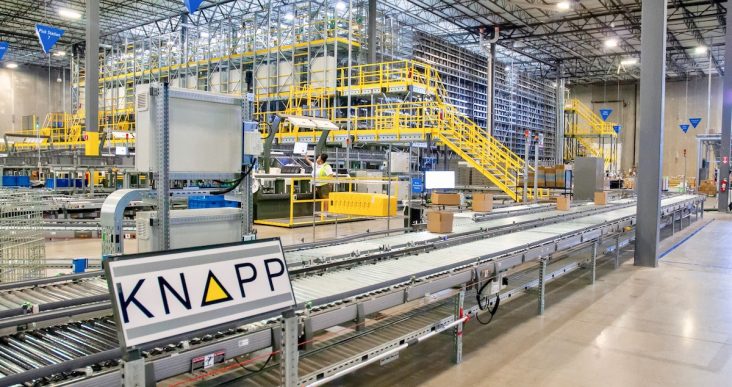Walmart to build 4 automated fulfillment centers, add 4,000 jobs
by June 3, 2022 10:08 am 3,503 views

Walmart’s four new fulfillment centers will be equipped with automation developed by Knapp that provides double the storage capacity and twice the fulfillment capacity. The facilities will open by 2024 and serve Walmart’s growing marketplace e-commerce business. (photo courtesy of Walmart)
Walmart plans to build four “next-generation” fulfillment centers by 2024 using Knapp systems designed to increase efficiency and order output. The new fulfillment centers (FCs) will be in McCordsville, Ind., Lancaster, Texas, Greencastle, Penn., and Joliet Ill.
The four new FCs could provide 75% of the U.S. with next- or two-day shipping on millions of items, including marketplace items – those sold by third parties using the Walmart website – shipped by Walmart Fulfillment Services. Combined with traditional fulfillment centers Walmart will reach 95% of the U.S. population with next- or two-day shipping, Walmart said.
Mike Prince, Walmart’s vice president of innovation and automation, said the retailer is partnering with Knapp to develop and automate a high-density storage system that streamlines a manual 12-step process into five steps.
“These FCs provide double the storage capacity and double the number of customer orders we’re able to fulfill, all while creating a more comfortable work environment for associates,” Prince said.
David Guggina, senior vice president of innovation & automation at Walmart U.S., said the company uses 31 e-Commerce fulfillment centers and 4,700 stores located within 10 miles of 90% of the U.S. population to fulfill orders at exceptional speed. But he said more work is needed to bring efficiency and speed to the growing marketplace sellers who have signed up for Walmart Fulfillment Services.
“These FCs will be the first of their kind for Walmart, using the powerful combination of people, robotics, and machine learning to set an entirely new precedent for us on the speed of fulfillment while continuing to create a positive work environment for our associates,” Guggina said.
He said the patent-pending process uses the following five steps:
Unload: Sellers and suppliers send merchandise in cases to an FC. As the cases arrive, employees unload the trailers and place cases onto a conveyor belt where they’re routed to receiving.
Receiving: At receiving, an employee breaks the case apart and places items into a tote. The tote is placed in an automated storage system where a shuttle transports it to one of millions of designated locations. The storage system is designed to account for every square inch, spanning from floor to ceiling in a custom-built structure designed to hold the inventory.
Pick: When a customer places an online order, the system retrieves their items and shuttles needed totes to an employee at a picking station. This is helpful for employees who traditionally would have walked up to nine miles per day, picking items from multiple floors of shelving spread out over hundreds of thousands of square feet of space.
Pack: Simultaneously, a custom box is created to fit the exact measurements of the order and sent to an employee for packing. In the packing area, Walmart estimates employees can assemble up to four orders at once and send packages to be shipped in less than 30 minutes after the customer clicks to order.
Ship: The completed order is automatically taped, labeled, and routed to its designated zone where it’s shipped to its final destination.
Guggina said the priority is to strategically locate the new FCs to pair most effectively with Walmart’s 4,700 stores and 210 distribution centers. He said together, this system of fulfillment assets will be optimized to get orders to customers fast and efficiently.
He said Walmart is also retrofitting regional distribution centers with more automation and robotics developed in-house and with partners like Knapp, Symbotic and Witron.
